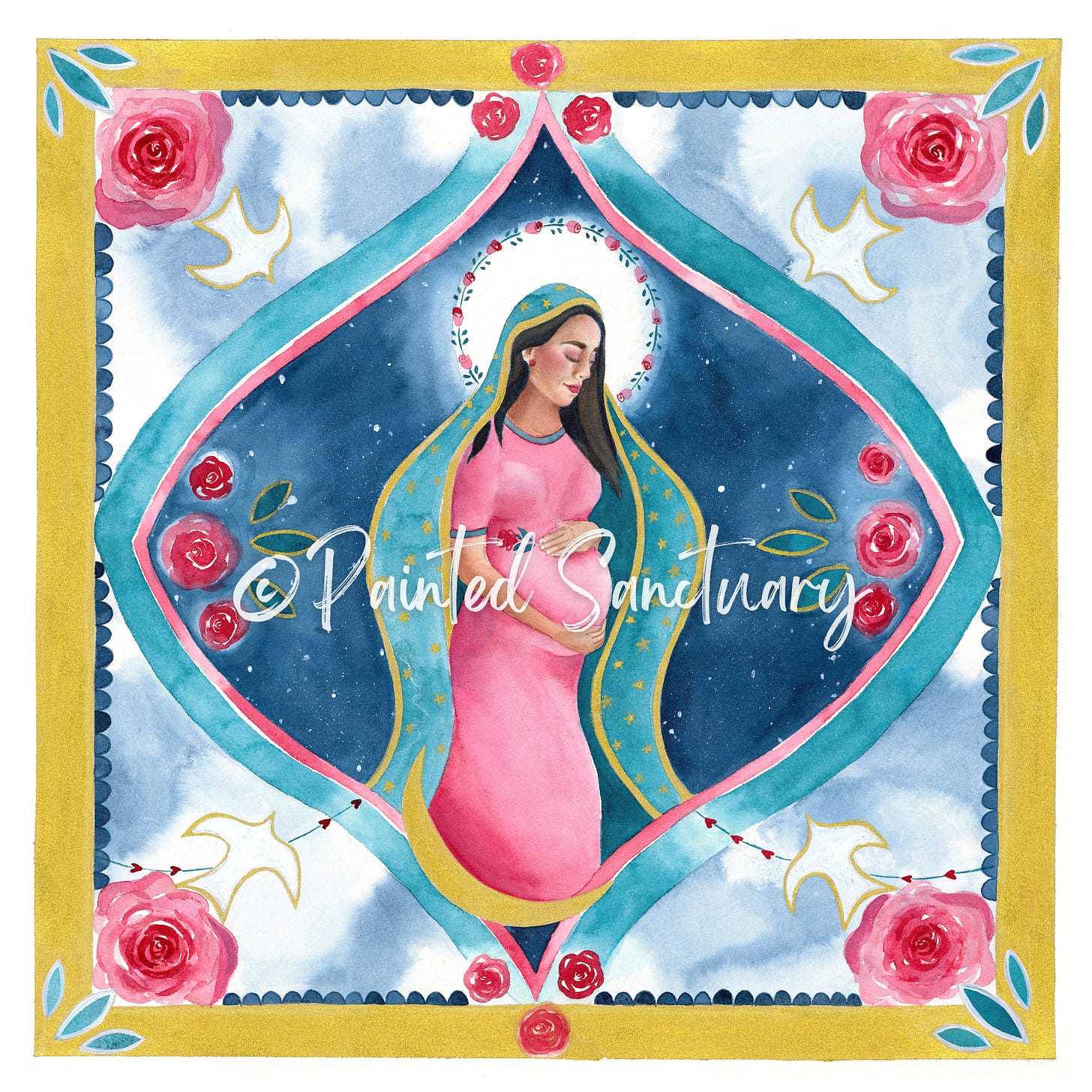My wife, Kristina, is the artist behind Painted Sanctuary. She recently painted a version of Our Lady of Guadalupe as a part of a series of folk art pieces. She wrote a personal story and reflection with that painting that I wanted to share here.
As promised I wanted to share a bit about Our Lady of Guadalupe and the way she showed up for me during the process of painting her.
I've shared briefly before that this year has been especially hard for my family. Early this March my husband left his job at our Church over unexpected and unfortunate circumstances, and while both of us knew deeply that this was where God was leading, the next months were heart-wrenching, anxiety filled, and we experienced grief, loss, and disappointment after disappointment.
His job had been more than a job, it was the whole reason we put roots down in this small town, it was the center of our community in many ways, it was an integral part of our identity here.
Him leaving his job at the parish would have been hard enough, but added on top was personal slander against him and other parish staff members. And everyone who had the power to do anything chose to let the harm continue.
During all of this, we were supported in astounding ways by many people in our small town, and God spoke through their generosity (and continues to) to reaffirm that we are where he wants us.
But, months later, when I began painting Our Lady of Guadalupe, I still found myself in a very difficult place. I did vaguely know her story -I heard it as a kid and was struck then by the miracles surrounding the apparition, but I had never really connected with her. So, I began doing research in order to incorporate key symbols into the piece.
Here's a very brief history of this Marian apparition. And for those who don't know much about it, I would encourage you to look it up because there are some really cool miracles that I leave out.
According to tradition, in 1531 Mary appeared to a native Mexican man named Juan Diego. During that time in history, the natives of Mexico were being oppressed by the Spanish, and as a result, they experienced much suffering & oppression as their culture and identity were being attacked.
Mary appeared as a young indigenous pregnant woman, wearing native Mexican clothing and speaking the native language. She requested that a church be built on that site, and so Juan went to the archbishop in Mexico City to make this request. The Archbishop didn't believe him and asked for a sign, to confirm that this was truly a miraculous encounter.
A couple days later, Mary appeared to Juan again and instructed him to pick flowers from the top of Tepeyac Hill. This was an unusual request as the area was usually barren - especially in December. He went anyway, and discovered beautiful Castilian roses blooming there. These roses were not even native to Mexico. He brought the flowers as a sign to the archbishop, and to both of their surprise, not only did beautiful roses fall out of his cloak, but the image of Our Lady of Guadalupe was miraculously imprinted on his tilma. This image remains, even until today. And the site of this apparition is one of the most visited places in the world.
There were a few themes that stood out to me as I read various commentary on this apparition. The first was hope. Mary appeared to Juan during a very dark time, a time where he and his people were experiencing oppression - and there was no end in sight. Juan was looked down on because of his heritage, degraded, and his very identity was being attacked. In this context, Mary's care for him and the way that treated him with dignity was especially striking. She came to him as a mother, as someone who deeply cared about him and his situation, as someone who would be with him in that dark place & be a sign of hope there.
Another theme is the beautiful way she identified with the oppressed and vulnerable. She wore their clothes, spoke their language, and her image on the tilma will always depict her in the likeness of an indigenous native of Mexico. She is a symbol of Justice, of motherhood and new birth, and her famous line, "Is it not me who is your mother," is just another example of her closeness with us.
Almost immediately as I started reading, I knew that she was choosing to reach out to me in the situation I was in. Because while my experience pales in comparison to the oppression of the Mexican people, I can still identify with Juan in my own small way.
Prior to the research that I did, I didn't know she was a symbol of hope, justice, new birth, and closeness to the vulnerable. And as I read, I got goosebumps because I knew that she was the mother that I need right now. And she knew that, even though I didn't. So she used my art and my painting to introduce herself to me once again -as an adult this time. And I felt seen, and loved.
This is just one of the many consolations that God has given me this year, and each one is welcomed and is reassurance that I am still in the right place, still seen, still loved...even on the hard days.
Check out Painted Sanctuary for this beautiful print and many others.




